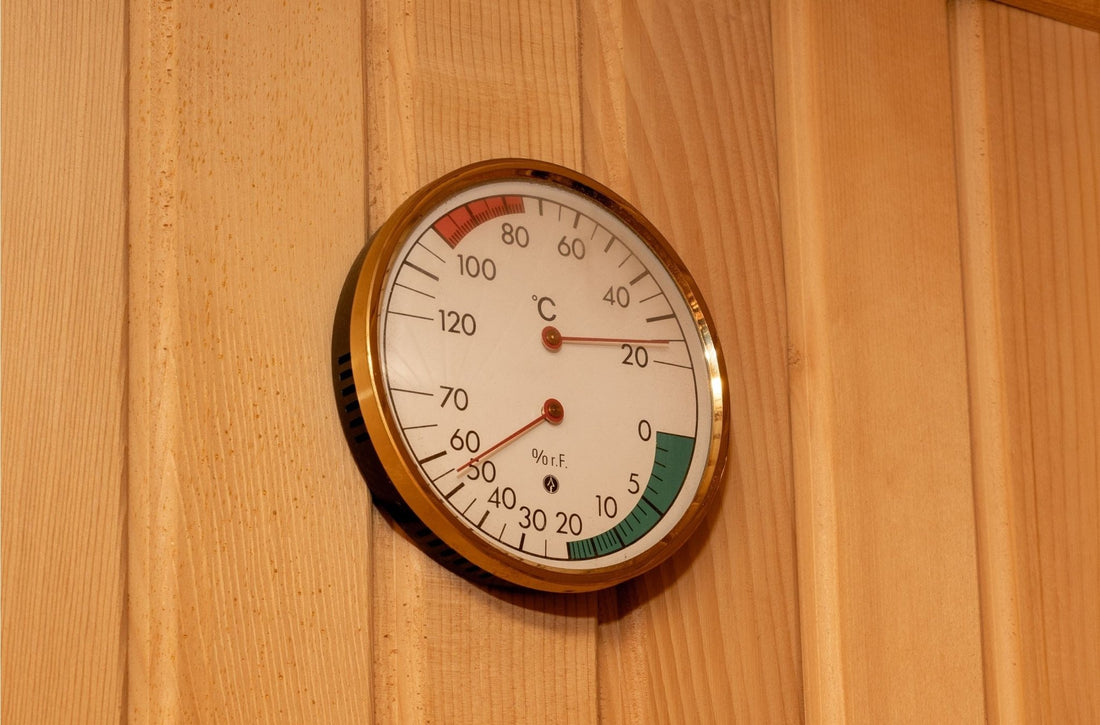Understanding the ideal temperature for a dry sauna is crucial to maximizing the health benefits and overall experience. There are several types of saunas, each with different temperature ranges. It is essential to identify the option that best aligns with your personal preferences and requirements.
Temperature recommendations per sauna type
Traditional Finnish saunas
Finnish saunas are usually heated between 70°C and 90°C. This range is preferred for its intense heat, which induces a deep sweat and provides deep relaxation. The arid heat is often intensified by steam jets, generated by pouring water on heated rocks, temporarily raising the humidity. Studies indicate that the most favorable effects on health occur between 80°C and 100°C, where improvements in cardiovascular health and a reduction in stress become more evident.
Infrared saunas
Infrared saunas operate at lower temperatures, usually between 49°C and 60°C. Instead of heating the air, infrared saunas use infrared light to heat the body directly. Studies have shown that this temperature range can promote muscle recovery, improve circulation and reduce inflammation. The gentler heat allows for longer sessions, which can amplify these therapeutic effects.
Steam saunas
Steam saunas, or steam rooms, maintain a much lower temperature, usually between 43°C and 49°C. However, the high humidity (100%) makes the environment seem much hotter. Research suggests that this temperature range is beneficial for lung health, as the moist heat can make breathing easier and reduce congestion. High humidity also benefits skin health, helping to open pores and promote detoxification.
Health considerations
Benefits of maintaining the correct temperature
Keeping the sauna at the recommended temperature has great health benefits, such as improving blood circulation, removing impurities and reducing stress. The correct temperature also increases relaxation and rejuvenation without putting excessive stress on the body. Research has particularly highlighted the advantages of sauna use at temperatures between 80°C and 100°C, noting significant drops in blood pressure, improved heart function and improvements in mental health.
Potential risks of incorrect temperatures
Excessively high temperatures can cause dehydration, dizziness or even heatstroke, especially in beginners or people with certain health problems. On the other hand, excessively cold temperatures may not offer all the health benefits of sauna use.
Recommendations for different user groups
Beginners: Start with the lowest temperature, gradually increasing it as your body gets used to the heat.
Experienced users: Those who know their way around saunas can withstand higher temperatures with ease, but it is essential to pay attention to the body and rest when necessary.
Factors influencing the choice of temperature
Personal preference vs. traditional guidelines
Although traditional guidelines offer a good starting point, personal comfort should always guide your sauna experience. Some people may opt for milder temperatures for extended sessions, while others may like the intense heat of a classic sauna.
Impact of climate and external environment
The weather outside can influence your sauna experience. For example, on cold days, a sauna with a high temperature can be invigorating, while in hot weather, a milder temperature can provide greater comfort.
Additional considerations for an optimal sauna experience
Horizontal positioning in the sauna
An important aspect of sauna bathing is the position of your body during the session. Lying horizontally in the sauna ensures that the whole body is exposed to the same degree of heat, creating a uniform experience. This is especially advantageous as it prevents the head from being subjected to significantly higher temperatures than the feet, something that can happen when lying in an upright position, resulting in a more pleasant and balanced exposure to heat.
Wearing a sauna hat
A sauna hat, usually made of wool or felt, is a valuable accessory for those who enjoy long sauna sessions or prefer higher temperatures. The hat helps protect the head from overheating by providing insulation against the intense heat. This allows the body to stay in the sauna longer, as the head is often the first part to feel discomfort from the heat. In addition, wearing a sauna hat can help maintain a stable body temperature, allowing for a more comfortable and prolonged sauna experience.
The importance of choosing the right heater
Selecting a heater that matches the size of your sauna room
Choosing the right heater for your sauna is crucial to maintaining the desired temperature. The heater must be sized appropriately to match the volume of the sauna room. A heater that is too small may not reach the desired temperature, while one that is too large may cause excessive heat variations, making the space uncomfortable and even unsafe. Ensuring that the heater is appropriate for the size of the sauna and its insulation helps to maintain a stable and pleasant temperature throughout the session.
The appropriate sauna temperature depends on the type of sauna and personal preferences. In the classic Finnish sauna, the ideal temperature is between 70°C and 100°C, and the health benefits are most pronounced between 80°C and 100°C. Infrared saunas work best between 49°C and 60°C, providing benefits such as improved blood circulation and muscle recovery. On the other hand, steam saunas should be in the 43°C to 49°C range and are beneficial for respiratory and skin health. It is important to consider your position in the sauna, wear an appropriate hat for greater comfort and choose a heater suited to the size of the space to ensure a pleasant experience.
If you have any questions about optimizing your sauna room and temperature, we'll be happy to help. You can contact us by sending a message here.


